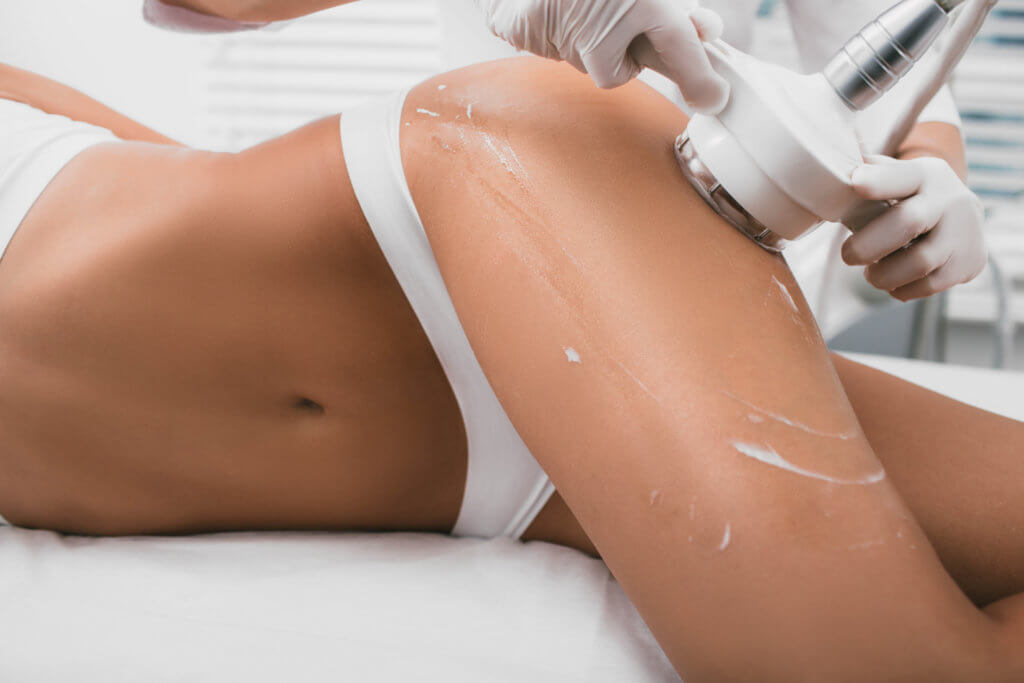Noninvasive body contouring has become a growing presence in today’s cosmetic procedure market. More and more customers are looking to shape their bodies without the discomfort and wide array of potential risks that stem from traditional liposuction procedures.
Traditional liposuction is quite an invasive procedure, given that it utilizes general anesthesia, a scalpel, and stitches. The nature of these procedures implies discomfort and grave risks if the surgery is botched.
Due to these risk factors, several noninvasive fat procedures have developed to strike a balance between comfortable and effective fat elimination. Some of these treatments use laser energy to destroy fat, some freeze the fat cells, while others still use radiofrequency waves.
One relatively new technique uses a different type of energy, ultrasound energy, to get the job done in a noninvasive manner. Ultrasound fat reduction machines use focused ultrasonic waves to destroy the lining in fat cells, prompting them to release their contents. Similar to laser energy, ultrasound waves pass through the skin without harming surrounding tissue or skin. This energy creates changes in pressure that cause the fat cell walls to break down; the material released is then metabolized over the following weeks.
This article will review two of the significant brands performing noninvasive ultrasound lipolysis: UltraShape and Liposonix. While they use similar energy forms, these procedures are entirely different from invasive, ultrasound-assisted liposuction treatments.

UltraShape
UltraShape uses ultrasound technology to contour the body and eliminate fat cells, specifically in the abdomen and flank area. It was the first ultrasound technology procedure to gain FDA-approval, and also recently become approved for use on the thighs.
UltraShape does not require anesthesia, meaning that patients avoid related complications. Procedures last about an hour and are done by applying a special gel and belt around the abdomen. Once the belt is in place, the trained physician will then use a tool called a transducer to deliver ultrasound energy below the surface of the skin to rupture the fat cells.
One session should last about an hour, and involves minimal recovery time. A clinical study revealed a 32 percent reduction in abdominal fat thickness occurs following an UltraShape procedure. Like most noninvasive fat procedures, patients require several treatments for optimal results. In the case of UltraShape, three sessions, two weeks apart, are recommended.
Additionally, this method uses pulsed ultrasound technology, which, unlike LipoSonix’s process, is nonthermal. Another difference between UltraShape and LipoSonix is that the former’s technology has a controlled depth, meaning its focus cannot be adjusted to deeper or shallower levels of fat. UltraShape devices rely on a real-time guiding system to prevent the overtreatment of a particular area and ensure uniform coverage throughout.

Liposonix
Also cleared by the FDA, LipoSonix uses high intensity focused ultrasound energy adjusted to a specific depth to maximize the waves’ focus on subcutaneous fat tissue. High intensity focused ultrasound energy causes targeted cells to experience a rapid increase in temperature. Unlike UltraShape treatments, which do not provide a temperature increase, this method can cause fat tissue to undergo a 70-degree Celsius temperature rise. Because of this temperature increase, LipoSonix sessions may hurt more than UltraShape ones.
Notable advantages of this treatment include the machines’adjustable depth settings and unique wave pattern, which maximizes the delivery of ultrasound energy. LipoSonix sessions last between 30 and 60 minutes for full abdominal treatments.
The Liposonix system, a cart-based machine, is only available for use on the waist and flank areas of the body. Each treatment takes around an hour to complete, and patients require up to five sessions.
Price for Ultrasound Lipolysis: UltraShape vs. Liposonix
The American Society for Aesthetic Plastic Surgery (ASAPS) indicates that the average price for an UltraShape is around $1,458 per treatment. Liposonix will cost between $1,500 and $3,000, depending on the experience of the physician, geographical location, and the specific areas to be treated.
Candidates for Both Ultrasound Fat Procedures
It is important to note that neither Liposonix or UltraShape should be considered to be weight-loss methods. They simply target fat in the waist and flank area.
Both procedures are intended for patients who have a healthy lifestyle. Patients that have a Body Mass Index over 30 are not recommended to undergo these procedures. Candidates should have at least an inch of fat if they want to get UltraSculpt or Liposonix
Risks of Liposonix and UltraShape
You’ll feel a warm or tingling sensation during the procedure, with minimal to no discomfort. Because Liposonix involves a temperature increase, these procedures may prove to be slightly more uncomfortable. In each case, fat will be eliminated without harm to any surrounding tissues.
Some patients have reported bruising and blisters that disappear after a short period. Nevertheless, you will not experience the invasive risks commonly experienced during traditional fat removal procedures.
